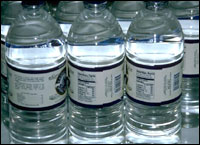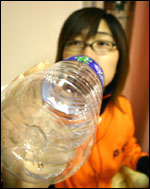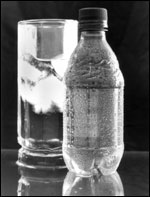
Thirsty for facts on bottled water?
When the United Nations declared 2003 the International Year of Freshwater, they likely weren’t thinking of Perrier. And yet bottled water has become freshwater’s most high-profile face, from Evian to Dasani and scores of other brands that now crowd store shelves.
Why have products that cost 240 to 10,000 times more per gallon than tap water soared in sales since the 1980s? According to the World Wildlife Fund, in 1976 U.S. consumption of bottled water was 5.7 liters per person; by 1999, it was 35 liters per person.
Americans say one of the main reasons they drink bottled water is because they believe it’s safer than tap water — and there is some reason to be concerned about tap-water quality in certain areas.
In a June 2003 study of tap water from 19 U.S. cities conducted by the Natural Resources Defense Council, the water quality and compliance of five cities was graded “poor” and eight were ranked as only “fair.” The U.S. EPA, for its part, has been found to have overstated the quality of U.S. drinking-water supplies in recent years. The agency claimed that 94 percent of Americans were served by drinking-water systems that met all health standards in 2002, while internal documents indicate that the actual figure is about 81 percent. [Editor’s note: Read a Grist article about the EPA’s exaggerated claims.] Particularly for vulnerable populations, such as children and pregnant women, a 1 in 5 chance of drinking unhealthy tap water presents an unsettling risk.
But is bottled water the rational alternative?
There are essentially three kinds of bottled water: natural mineral water, spring water, and purified water.

Once more into the drink.
Under the European Union’s definition, natural mineral water is “microbiologically wholesome water, originating in an underground water table or deposit and emerging from a spring tapped at one or more natural or bore exits.” The sources of these waters are protected from pollution, but since the water is not disinfected, it can contain microflora. In Europe, mineral water’s reputation as health booster can be traced back to the heyday of the Roman empire, but the actual benefits of these minerals are regarded today as minimal. In the U.S., natural mineral water is defined as having at least 250 parts per million total dissolved solids, according to the International Bottled Water Association, and derives from springs or boreholes drawing from a protected underground water source.
Spring water is similar to mineral water, but needn’t have a constant mineral composition and is usually cheaper.
Purified water is taken from lakes, rivers, or underground springs and treated, all of which makes it almost identical to tap water.
(The IBWA also has specific definitions for artesian water, well water, and sparkling water.)
These labels are not taken lightly. Last June, Nestle’s Poland Spring brand was hit with a class-action suit contending that the Poland Spring hasn’t flowed since 1967 and that the product is falsely labeled as spring water when in fact it comes from human-drilled wells.
To prevent deceptions of the sort alleged in the Poland Spring case, legislation was introduced into the California Assembly in April that would make bottlers list water sources and contaminants. “Seventy percent of Californians get some or all of their drinking water from bottled or filtered sources, so they ought to know what’s in it, since they’re paying a premium,” says Rebecca Nieto, chief of staff for Assemblymember Ellen Corbett, coauthor of the bill. But Stephen Kay of IBWA contends that California consumers can get all the info they need by requesting water-quality reports via the phone numbers and addresses listed on water bottles. He also argues that the bill would put an unfair burden on bottled-water companies because producers of other beverages such as beer and soda do not have to list the sources of and contaminants in the water they use.
In India, where bottled-water consumption has grown 50 percent annually over the past several years, contamination controversies have arisen over both bottled water and soda within recent months. Tests have found high pesticide levels in samples, resulting in the loss of governmental quality certificates from a number of brands and warnings issued to Coca-Cola and PepsiCo.

Going full-bottle.
And it’s not just Indian consumers who should be wary. A four-year study of bottled water in the U.S. conducted by NRDC found that one-fifth of the 103 waters tested contained synthetic organic chemicals such as the neurotoxins toluene and xylene and the possible carcinogen and neurotoxin styrene. Though NRDC reported that most bottled waters tested were of good quality, one-third of the products were found to violate an enforceable state standard or exceed microbiological purity guidelines, or both, in at least one sample.
NRDC calls for water-bottle labels to disclose full information on the water source, how the water is treated, and what contaminants it contains. Despite popular misperceptions (spawned primarily by advertising), bottled water is not regulated as strictly as tap water. In fact, unlike tap water, regulations allow bottled water to contain some contamination by E. coli or fecal coliform and don’t require disinfection for cryptosporidium or giardia. And, as Consumer Reports tests discovered in August 2000, unhealthy chemicals can migrate from plastic bottles into the water.
Sometimes bottled water is tap water: In spite of the springs, mountains, and other bucolic scenes depicted on labels, some bottled water is nothing more than tap water, NRDC and Consumer Reports have found. The Aquafina brand, for example, is drawn from the municipal water supplies of Detroit, Fresno, and other cities.

Tap dance.
The first step to clean drinking is to check out the quality of your tap water. Under the Safe Water Drinking Act, consumer confidence reports must be made publicly available, showing the levels of contaminants in local drinking water. Visit the U.S. EPA’s local drinking water information page to find the report for your area.
If you learn that your water has worrying contaminants, you might want to consider purchasing a water filter rather than buying all those bottles and contributing to mountains of plastic waste. An estimated 1.5 million tons of plastic is manufactured from petrochemicals each year to package water, according to an April 2001 report by the World Wildlife Fund. In 1999 alone, about 1 million tons of plastic bottles wound up in U.S. trash bins, the EPA estimates.
For just pennies a day, a water filter can provide safe drinking water for you and your family. You’ll not pay anything extra for transportation costs or cheap packaging that harms the environment. You can store your filtered water in a container in your fridge or take it with you in a convenient reusable bottle or thermos.
TerraFlo sells water-filtration products with recyclable filters and runs a recycling program to collect those filters. Also, the following table lists some of the best filter systems, according to National Sanitation Foundation certifications and Consumer Reports’ August 2000 and October 1999 ratings. And find out more from a Green Guide report on water filters.
| Model | Type | Cost | Annual cost to replace filter | Filter type | Contaminants removed |
| Pur Ultimate FM-4010L | Faucet-mounted | $50 | $96 | Carbon | 29, including lead, THMs, microbes, alachlor, atrazine, benzene, chlorine, mercury, styrene, 2,4-D, MTBE, perchloroethylene, toluene, trichloroethylene |
| Pur Ultimate CR-900 | Carafe | $28 | $78 | Carbon | 24, including lead, THMs, microbes, atrazine, benzene, cadmium, chlorine, mercury, MTBE, perchloroethylene, toluene, xylenes |
| Pur Plus FM-3000 (or FM-3550) | Faucet-mounted | $35 | $72 | Carbon | 14, including lead, microbes, chlorine, atrazine, mercury, 2,4-D |
| Brita Pitcher | Carafe | $20 | $27 | Carbon | 12, including lead, chlorine, copper, zinc, mercury, cadmium, xylenes, benzene, perchloroethylene, toluene |
| Culligan FM-15 | Faucet- mounted | $17 | $60 | Carbon | 5, including atrazine, microbes, lead, lindane, chlorine |
| Culligan Polar Bear 26-M | Countertop | $600 | ? | Distiller | 11, including arsenic, lead, cadmium, mercury, fluoride |
| Culligan AC-30 Aqua-Cleer® Good Water Machine™ Culligan AC-30L Nitrate | Plumbed in to separate tap | $875 (with installation) | $298 | Reverse Osmosis | 12, including arsenic, lead, microbes, copper, fluoride, radium |
| Pure Water Mega-Classic | Plumbed in to separate tap | $1,999 | $45 | Distiller | 11, including arsenic, cadmium, copper, fluoride, lead, mercury, selenium |
| Gaiam Terracotta Ceramic Water Filter | Crock | $159 | $59 | Ceramic, Carbon, and Particle | 25, including chlorine, aluminum, asbestos, lead, some pesticides, microbes, bacteria |
| Gaiam UV Water Filter | Plumbed in to tap | $489 | $125 | Ultraviolet | 23, including aluminum, benzene, bacteria, chlorine, copper, microbes, lead, mercury, some pesticides |

